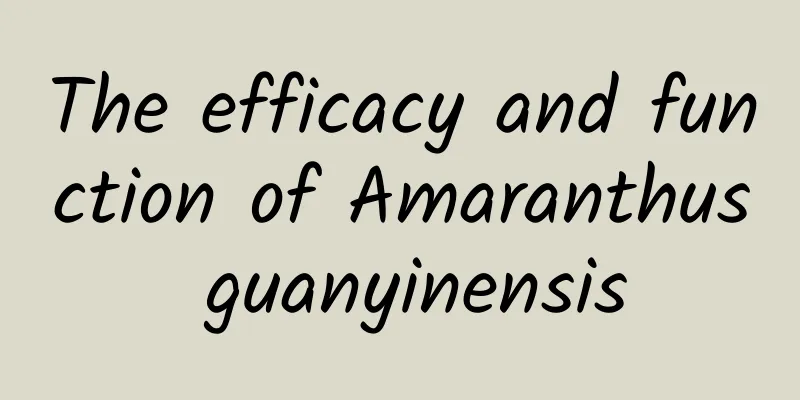The efficacy and function of Amaranthus guanyinensis

|
We know that there are many kinds of Chinese medicinal materials, and Amaranthus aviculare is one of them. In order for Amaranthus to play its role correctly and scientifically, it is necessary to master the method of eating it, because different medicinal materials have their own unique nutrition and efficacy. Let’s study it below. [Alias] Auricularia auricula, blood-skin vegetable (Illustrated Catalogue of Plant Names and Realities), Panax notoginseng (Kunming Medicinal Plant Survey Report), blood-skin vegetable, purple-backed skymarsh (Chongqing Herbs), red amaranth, red-haired amaranth, red amaranth, red vegetable, angelica vegetable, red jade vegetable (Fujian Chinese Herbal Medicine). [Source] It is the whole herb of Amaranthus affine . [Original morphology] Perennial erect herb, 30 to 60 cm tall, smooth and hairless all over. Leaves are alternate: elliptic-lanceolate, 6-9 cm long, 1.5-3 cm wide, thick and soft, pointed at the tip, cuneate at the base, extending downward into an ear shape, with irregular serrations on the edges, green above and purple-red below; petioles are short, purple-red, and the upper leaves are almost sessile. The inflorescence head is terminal or axillary, several of which are arranged into loose panicles or corymbose inflorescences; the inflorescence stalk is slender and bifurcated; the bracts are in one row, linear; all the flowers are tubular, yellow. Achenes linear, pappus abundant. Flowering period is summer. [Habitat distribution] Grown in wilderness wetlands, or cultivated in vegetable gardens. Distributed in Fujian, Taiwan, Jiangxi, Guangdong, Guangxi, Sichuan, Yunnan and other places. [Nature and flavor] "Fujian Chinese Herbal Medicine": "slightly sweet and spicy, neutral." 【Functions and indications】Promote blood circulation and stop bleeding, detoxify and reduce swelling. Treat dysmenorrhea, metrorrhagia, hemoptysis, traumatic bleeding, and ulcers that do not heal for a long time. [Usage and Dosage] For oral use: decocted in water, 0.5-1 liang (2-3 liang for fresh). For external use: grind into powder and sprinkle or mash for application. [Additional prescription] ① Treatment of diseases: 2 to 4 liang of fresh Amaranth leaves, stir-fry with wine three to seven times, stew with boiling water, and take before meals. 【Excerpt】 《*Dictionary》 【Source】 From "Chongqing Herbs" The above describes some ways to eat Amaranthus guanyinensis. Although many medicinal herbs can be eaten, we must remind everyone that Chinese medicines generally cannot be taken indiscriminately and should be used according to your own situation. |
<<: The efficacy and function of razor shell
>>: The efficacy and function of Guanyin Lotus
Recommend
Do you need to use antibiotics immediately when you have Mycoplasma pneumoniae infection? Here comes the list of scientific rumors for October →
1. Does Mycoplasma pneumoniae infection require i...
How to promote children's growth? These exercises can help!
The height of children is a problem that many par...
Using the atmosphere to make dumpling wrappers? Chinese scientists' latest research is quite amazing!
Chinese scientists recently reported for the firs...
Can drinking Jiaogulan in water lower blood pressure?
In our lives, many people are under great pressur...
The efficacy and function of purple back geranium root
Only when we understand the main ingredients of a...
Strawberries are the "dirtiest fruit"? Why do experts recommend eating them? The truth is...
This article was reviewed by Pa Li Ze, chief phys...
The efficacy and function of Ghana incense
Chinese medicinal materials are very effective in...
Are mini vegetables more nutritious than regular vegetables?
Rumor: Mini vegetables are newly cultivated veget...
Rare! Woman pregnant with octuplets, don't use ovulation-stimulating drugs indiscriminately
recent A woman from Zhengzhou, Henan Pregnant wit...
Is the tiger the king of the sea? Is the tiger's skin green? How can we celebrate the Year of the Tiger if we don't know the truth?
I wish you all a happy Year of the Tiger! Mixed k...
Hot search! Many people are looking for oyster sauce in the kitchen these days...
Oyster sauce is one of the indispensable seasonin...
What is Aisong
What is Artemisia? In our daily life, we generall...
A couple died from being stung by a "human-headed bee"! How to deal with being stung during the high "bee" season in autumn?
Recently, a couple in their 80s from Nanyang, Hen...
The efficacy and function of Atractylodes macrocephala
Atractylodes can strengthen the spleen and replen...
The efficacy and function of goose kidney
Goose kidney is one of the common traditional Chi...





![The efficacy and function of dried ginger[picture]](/upload/images/67ca74bf6d623.webp)


![Effects and functions of Guangzao [picture]](/upload/images/67ca69998d527.webp)
